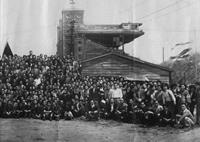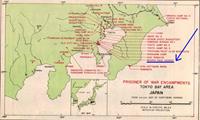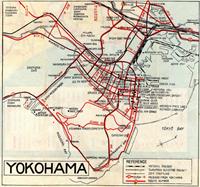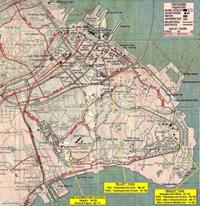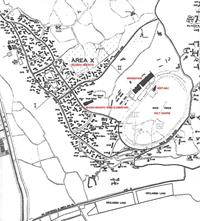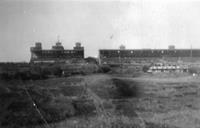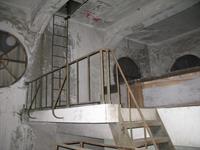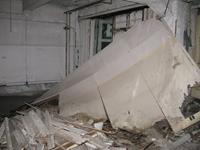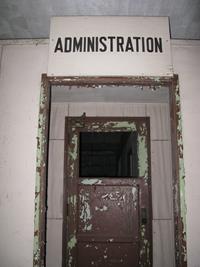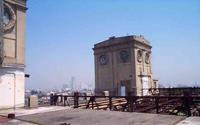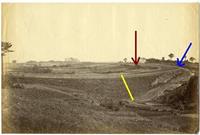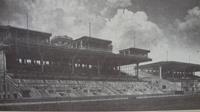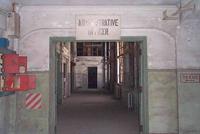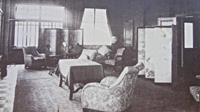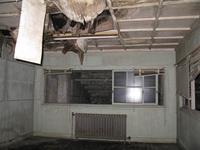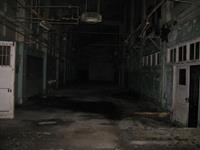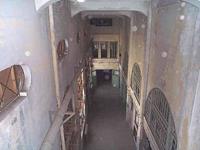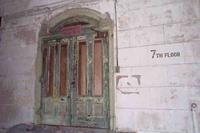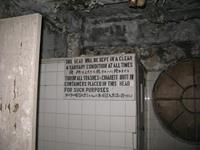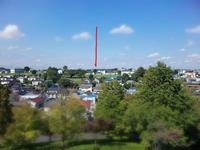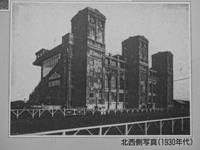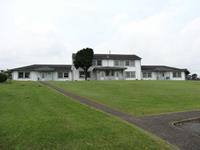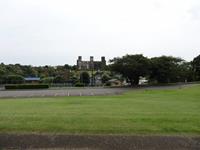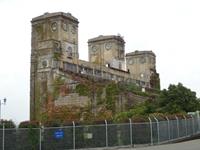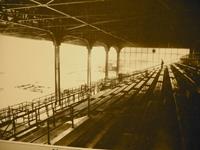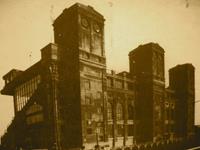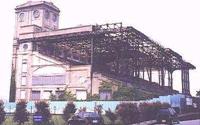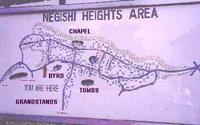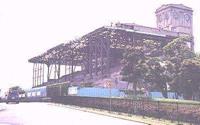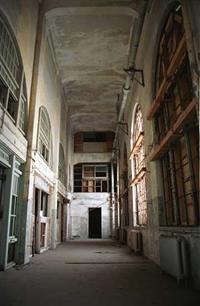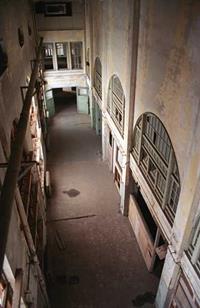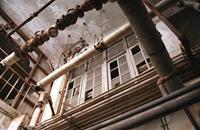Kanagawa Civilian Internment Camps
Special Division
Department of State,
To: War Department (PMG)
Department of State,
To: War Department (PMG)
Bern, August 6, 1943
Via Air Mail PouchNo. 5807
Subject:
American Interests - Japan
Camp report No.1 on civilian internment camp at Yamakita (Yamashita.)
visit made:
July 6, 1943
July 6, 1943
Negishi camp at Yokohama was discontinued on June 25, and internees transferred to camp at Yamakita in the prefecture of Kanagawa.
A) Site.
Camp Yamashita is one hour's walking distance from Yamakita, located two hours by rail from Yokohama.
Camp is laid out on hilly country side with mountains in view. Surrounded by orange plantations. Camp is not enclosed by any fence or barrier. Nearest village is 15 minutes away.
Yamashita camp is under police direction of the Kanagawa precinct. Order is kept by a brigadier and four policemen. Three British subjects compose the internee committee.
There are 53 persons in this camp, which was built to house 55. 22 are British, 13 Canadians, 10 American citizens. All internees are from the former Negishi camp which was closed on June 25 and moved here.
Layout.
Camp is composed of two buildings, one European style, the other Japanese style. Both are two stories high and face south. Kitchens are in separate buildings.Rooms are light and airy, electricity has been installed and there is a laundry at the disposal of the internees.
Food.
Food is satisfactory. There is no camp canteen but internees are able to order supplies from outside merchants.
State of health.
A doctor, surgeon, dentist and hairdresser are at the disposal of the internees in camp.
Sports and recreation.
Internees are allowed to be outdoors all day. Some do gardening and there is a library with books from the former Negishi camp. Internees receive two Japanese newspapers written in English.
Conclusion.
Lodging and treatment of internees is satisfactory, discipline is good; up to present time there have been no disciplinary measures taken and none seem to be in view.
YM
(Japan)
TRANSCRIPTION BY THE LONDON DELEGATION OF THE INTERNATIONAL RED CROSS COMMITTEE
Kanagawa Prefectural Civil Internment
Camp No. 1.
visited on January 31st 1944 by Dr. H.C. Angst
| MAIL ADDRESS | c/o Foreign Section, Kanagawa Prefecture, Yokohama. |
|---|---|
| OPENED | June 25th, 1943 |
| CAPACITY | 60 |
| STRENGTH | On visit day 49 Whereof: British 23 (including one Irishman, E. Burke, oldest inmate of camp, holding letter from Swiss Minister in Tokyo affirming his citizenship of neutral Eire : in the circumstances is at a loss to understand reason of his having been interned) Canadians 13 (12 Catholic Fathers, 1 teacher) Americans 7 Greeks 3 Without nationality 3 |
| ORIGIN | Yokohama Civil Internment Camp No.1. Some originally from Yokohama Camp No. 2, which camps have both closed in the meantime. |
| AGE | Minimum 21 Maximum 74 |
| CAMP LEADER | Charles Henry Moss (British) and 2 assistants George Will Moss (British), George Edward Beatty (British) and 7 Group Leaders, each representing group of seven. |
| CAMP LOCATION | Azakamiyama 2586
Uchiyama, Kitaashigaramura, Ashigarakamigun, Kanagawa Prefecture;
isolated in healthy, fertile farm region on sandy slope among mandarin
groves, commanding nice view. Elevation 150 metres. Current outdoor night temperature below freezing. |
| FORMER USE OF CAMP | Catholic priests summer residence. |
| AREA | Over 6,000 square metres. |
INTERNATIONAL RED CROSS COMMITTEE
February 25, 1944
Delegate at Japan accompanied by delegates of the Japanese Red Cross of the Yokohama chapter visited January 31 Kanagawa Prefectural Civilian Internment Camp No.1, Mail address: Care Foreign Section Kanagawa Prefecture, Yokohama.
Opened June 25, 1943. Capacity 60.
Camp commandant Koganei, liaison officer between camp and prefecture Sekiguchi.
On day of visit there were 49 internees in camp. 13 Canadians, 7 Americans, 23 British, 3 Greeks, and 3 others of unknown nationality.
Camps #1 and #2 both closed since telegrams 82 and 88.
Camp Leader is Charles Henry Moss, British, with two assistants, both British.
Camp is located - Azakamiyama 2586 Uchiyama Kitaashigaramura Ashigarakamigun Kanagawa Prefecture, in healthy region on sunny slope among mandarin groves. Elevation 150 meters, current outdoor temperature sub-zero. This is a former summer residence of the Catholic priests.
Enclosure is low bamboo fence. Both buildings of this camp are in need of repair. One is an old foreign style dwelling and one a Japanese style dwelling with paper panels, no outside panels of wood. Rooms - one large, one medium and 2 small. Enclosed veranda on ground floor. Same style on second floor. All used as dormitories.
Space is insufficient and overcrowded. Some sleeping on tables. Light sufficient. No heating.
Open cesspools, no septic tank. Water supply from spring.
Some beds brought by internees, others supplied by authorities.
Toilet and urinal outside. Hot bath 6 times monthly. 2 showers at present not in use.
P/PFV/PFV
Japan.
Kanagawa Prefectural Civil Internment Camp No. 1
Visited by M. Pastalozzi on August 24th
1944.
ACTING CAMP COMMANDER:
Police Sergeant WatanabeSTRENGTH ON DAY OF VISIT:
22 British (one is Irish)Total: 48
13 Canadians
7 Americans
3 Greeks
3 other nationalities
CAMP LEADERS:
Charles Henry Moss, British and ten group leaders.FOOD:
According to the Camp Authorities the daily food rations are unchanged. The weight of the internees is not checked, but the Camp Authorities admit that the internees are losing weight.HEALTH:
No cases of serious illness.WORK:
H. G. P. Bruhl, British, died on July 13th 1944 from complications of hernia operation. The internee had been ailing for a long time. The remains were cremated in Odawara on July 14th 1944 and the ashes were deposited in the Yamate Cemetery, Yokohama.
Seven to ten internees work voluntarily at the Farmers' Association in the nearby village of Uchiyama where they help to make pickled prunes "Umeboshi". As remuneration they receive two rice balls "Nigirimeshi" per day.VISITS FROM OUTSIDE:
They work from 8 to 11 am and from 1 to 5 pm.
Three men work in the vegetable garden inside the camp grounds where they grow potatoes, sweet potatoes, pumpkins, tomatoes and corn in small quantities.
Friends and relatives are permitted to see the internees twice monthly. The Camp Command no longer permits food to be brought from outside because they maintain that the rations for Japanese Civilians are so small that they cannot spare anything for internees and that therefore such additional foodstuffs are bought on the black market which is inadmissible. (Only foodstuffs sent by the Red Cross and/or Protecting Powers is admitted).WALKS:
Outside camp ground no longer permitted as on a number of occasions internees stole vegetables in the adjoining fields.RED CROSS RELIEF:
The internees gratefully received 23 pairs of boots and one firstaid kit ex "Teia Maru".CHARITY:
The Delegate distributed on the occasion of his visit 60 packages of cigarettes ex "Teia Maru".
The Japan Red Cross Society is assisting two internees with •100.- each and two with •80.- each monthly.INTERVIEW WITH CAMP LEADER AND GROUP LEADERS:
In presence of Camp Authorities.CORRESPONDENCE:
The internees desire another first-aid kit as the present one has been partly used. They would also like to get Vitamin pills and bandages. (A first-aid kit VI will shortly be sent to the camp).
As all the internees, with the exception of a few weak and old men, are hauling provisions from the nearby village Uchiyama and collecting firewood in the nearby hills, they are badly in need of boots. 23 internees received boots already early this year but the others also need some. (25 pairs XII ex "Teia Maru" will be sent shortly).
The internees regret that they have no facilities for shoe repairs.
In the way of clothing they badly require underwear and socks. (We are making arrangements to send three bales Heavy Clothing VIII and 15 overcoats XI to the camp. Unfortunately, there is not enough relief available to fit out all of them).
The internees find the food insufficient, although the quality and the variety have recently slightly improved. They are always hungry and many of them have weakened constitutions. They desire to buy foodstuffs from outside with their own funds. (We are sending 48 Cancross foodparcels and 48 Amcross foodparcels I to the camp).
They further require general necessities, matches, black and white mending thread, writing paper, mops and brooms for cleaning the premises. (It is difficult to find these things locally, but we shall try and see what we can do).
In the way of recreational articles they would like to have jigsaw puzzles, a big checker-board, new packs of playing cards, also a recent edition of a book on bridge; any other kind of game is of course welcome.
The French Canadian Fathers desire books in French. (We are submitting all these requests to the Neutral Committee of the International YMCA).
Internees Emery and Woodruff, both stateless, and E. Burke, Irish national, desire financial assistance. The four internees receiving aid from the Japan Red Cross Society would be grateful if their monthly allowance could be raised owing to the general higher price level. (We are approaching the Japan Red Cross Society in this matter).
The Canadian internees complain that very few cables and letters have reached them from Canada since they have been interned here. They have received altogether about five letters from Canada. Father Houde informed the Delegate that he had received in June 1944 a letter from his father in Canada dated December 9th 1943 acknowledging his letter of April 31st 1943.
H.C. Lepper (British) has received no letter from his wife in Vancouver B.C., although he had a cable from her early in 1943 informing him that she is writing monthly.
The Canadian Fathers, who formerly lived in Manchoukuo, would like to receive mail from their friends over there.
F.B. Booth (American) has been advised by a letter which he received per exchange vessel "Gripsholm/Teia Maru" that a comfortparcel had been sent to him. He has, however, never received this parcel. (We are making inquiries with the competent authorities in this respect).
Most of the internees, in particular the Canadian Fathers, who had been sent here from Manchoukuo for repatriation, are impatiently awaiting evacuation.
REMARKS:
No repairs have been made to either buildings or sanitary installations. According to the Camp Authorities no changes and improvements are contemplated. There will be no heating in the camp during the winter. As the camp buildings used to be a summer recreation home for Catholic Fathers, it is ideal during the warm months, but as soon as the weather gets cold, living between two paper walls without heating is very hard indeed. Internees told the Delegate that apart from performing various duties outside they spend most of their time in bed during the winter.
The quarters appear very crowded and the general aspect of the dormitories is rather depressing as the internees have piled up their few belongings on numerous small shelves.
(seal) COMITE INTERNATIONAL OF LA CROIX ROUGE
- GENEVE
Yokohama Civilian Internment Camps
TRANSLATION OF A CABLE RECEIVED FROM GENEVA JUNE 6, 1942
NLT INTERCROSS WASHINGTON82 OUR DELEGATE JAPAN VISITED ON MAY 30 CAMP NO. 1 RACECOURSE ADDRESS KENCHO YOKOHAMA STOP
SITUATED IN SOUTHERN PART OF YOKOHAMA ONE-HALF A KILOMETER FROM MERSUR [Negishi?] ON THE NORTHEAST COAST IN AN OVAL VALLEY OF 650 TO 450 METERS FORMING A RACE COURSE AND GOLF COURSE ISOLATED BY WILD HEDGES AND WALLS STOP
SURROUNDED BY CLAYISH HILLS COVERED WITH GARDENS CULTIVATED FIELDS BUSHES AND TREES STOP
AMONG INTERNEES ARE 16 UNITED STATES TRADESMEN FROM THE LOCAL VICINITY STOP
7 PASSENGERS FROM THE SHIP TATSUTAMARU EN ROUTE AND RETURNED TO JAPAN AT THE BEGINNING OF THE WAR STOP
ONE-STORY BUILDING FORMS THREE SIDES OF A RECTANGLE ENCLOSING A COURT OF 300 SQUARE METERS AND OPEN AT NORTH END STOP
NINE ROOMS OF 50 SQUARE METERS AND ABOUT 3 METERS HIGH EACH ONE WITH PANTRY AND TAP FOR WASHING STOP
AVERAGE OF SIX MEN TO A ROOM STOP
SMALL WINDOWS OPPOSITE LARGE DOORS OPENING ONTO THE COURT PERMIT SUFFICIENT VENTILATION STOP
THREE ROOMS WITH SOUTHERN EXPOSURE HAVE ADVANTAGE OF BREEZE DURING SUMMER AND SUN DURING WINTER THE OTHERS WILL BE HOT DURING THE SUMMER STOP
HEATING BY COAL FURNACE JAPANESE ALSO FURNISH HOT WATER STOP
REFECTORY STOP
JAPANESE BEDS ON MATTRESSES INSTALLED EACH EVENING ON TABLES IN NINE ROOMS ABOUT 10 INTERNEES PROFIT BY PERMISSION TO BRING EUROPEAN BEDS STOP
SUFFICIENT BEDDING STOP
WASHROOM LARGE JAPANESE BATH SHOWERS AND LATRINES ARE SUFFICIENT AND CLEAN STOP
SEVEN GOOD PROFESSIONAL JAPANESE COOKS MEAT OR FISH EVERY DAY STOP
ABOUT 200 GRAMS OF BREAD BUTTER WITH EACH MEAL STOP
POTATOES VEGETABLES RICE MILK SUGAR JAM TEA ETC. STOP
FOOD NOT WEIGHED SUPPLEMENTS FROM OUTSIDE WITHOUT RESTRICTION STOP
SUFFICIENT CLOTHING GOOD HYGIENE NO DEAD STOP
ONE AMERICAN SUFFERING FROM LIGHT CASE OF ENTERITIS CARED FOR IN MODERN HOSPITAL IN THE CITY STOP
June 8,
TRANSLATION OF A CABLE RECEIVED FROM GENEVA JUNE 6, 1942
NLT INTERCROSS WASHINGTON, D. C.
82 Visit made on May 30 to camp no. 1, Race course. Address Kencho, Yokohama.
Visit made by delegate of I.N.R.C. in Japan.
SITUATION.
The camp is situated in the southern part of Yokohama, one half a kilometer from Mesure [Negishi?] on the northeast coast. It is in an oval valley surrounded by hedges and walls. The valley is 650 to 450 meters, forming a racetrack and golf course. Clayish hills and gardens surround the camp.
INTERNEES.
There are sixteen tradesmen from local vicinity, and seven passengers who were on the Tatsutamaru, and were returned at the outbreak of the war.
DESCRIPTION.
The barrack is a one-story building forming a rectangle, enclosing a court of 300 square meters, and opening at the north. There are nine rooms 50 square meters and about 3 meters high. Each one has a pantry and a tap for washing. Each room has an average of six men. Sufficient ventilation. Three rooms facing the south have the advantage of breeze during the summer, and the sun during the winter. The others will be hot in the summer. Heating by Japanese furnaces.
BEDDING.
Mattresses installed on tables in nine rooms for internees. 10 internees have permission to bring in European beds. There is sufficient bedding.
WASHING AND TOILET FACILITIES.
There is a large washroom. Japanese bath and showers. Also enough latrines which are clean. Internees are entitled to one bath a week, while cold showers are unlimited.
FOOD.
There are seven professional cooks (Japanese). The internees have meat or fish every day and 200 grams of butter with each meal. Abundance of vegetables, rice, milk, sugar, tea, and jam. The food is not weighed and there is no restriction on supplies from the outside.
CLOTHING AND MEDICAL CARE.
Clothing and hygiene is good. One American has light case of enteritis and is cared for in the hospital in the city. The camp has good hospitals and the internees can obtain medical and dental care on request.
RECREATION AND RELIGIOUS ACTIVITY.
Space in the middle of the golf course for games and sports. The internees have picnics several times in the park, with beer and whiskies if they care for it.
CONFIDENTIAL
WOMEN INTERNED IN YOKOHAMA BOAT CLUB, YOKOHAMA, JAPAN
The following memorandum was prepared on board the M.S. Gripsholm by Miss Olive Hodges, American missionary repatriate. (See Sumire Internment Camp Report.)The memorandum is of interest because it indicates that in addition to those residents of Japan interned temporarily in the Yokohama Boat Club in 1942 and subsequently transferred to the Sumire Internment Camp, there was also a group of nineteen women, one American and eighteen Australians, held incommunicado in the Boat Club but understood to have been brought from New Guinea.
"In September and October, 1942, there were nineteen women (18 Australians and 1 American) interned in the Yokohama Boat Club. All that is known of them was learned by the women interned from September 18 to October 5 in the basement of the Boat Club and later transferred to Sumire Camp. The two groups of women were not permitted to see or to communicate with each other, so the little that is known was learned from the guards, during one hurried conversation through a locked door, and from stolen glimpses now and then.
"Among the nineteen women were 4 Methodist missionaries and 2 Army nurses. They had been in New Guinea. The husband of the American was supposed to have been killed in the Aleutians. They all seemed to be well although probably it was this American who gave birth to a child in the Yokohama General Hospital. The child died.
"In July 1943, the Swiss representative who visited Sumire in reply to a question about these women said, 'Officially we know nothing about them. We are not permitted to visit them. We've heard of them and I think they are still there."
S. S.
December 17, 1943
TRANSLATION OF A CABLE RECEIVED FROM GENEVA JUNE 10, 1942
NLT INTERCROSS WASHINGTON88--Delegate from the International Red Cross visited the camp on May 30. Yokohama Camp No. 2, Rowing Club. Address: Kencho.
GENERAL DESCRIPTION.
This camp is in the neighborhood of Yokohama. The ground around this camp has been recovered from the sea-shore, and is made up of rocks and clayish earth.
It is well drained, airy and sunny. It is a two story building with steel structure, covered with stucco. The first floor is concrete. Asbestos roof and the construction dates from 1939. First floor 330, second floor 300 square meters, 3-1/2 meters high with veranda of 150 square meters facing east and south.
INTERNEES.
. Among the internees are seven tradesmen from the local vicinity. These are Americans.
GENERAL FACILITIES.
Beds are made up each evening on the tables and floors of three rooms on the second floor. They use European mattresses. Ventilation is excellent and there is a central heating plant. Electric lighting.
There [are] enough washrooms, washstands, and latrines with running water intended for a club of 100 members.
There is a large Japanese bath and laundry.
FOOD.
The kitchen has a large frigidaire, and the cooks are Japanese professionals. Cooking is that of a middle class hotel. Food is not weighed and is abundant. Supplements from the outside are unlimited.
Daily ration consists of two bowls of rice, 1/2 lb. of bread, potatoes, vegetables, fruits, jams, one glass of milk, two cups of tea. The internees have eggs on Sunday, porridge and meat liver four times a week, and fish on other days.
CLOTHING.
Outer and under clothing of the internees is sufficient.
MEDICAL.
Health is good, weight of the internees is normal. The internees are allowed dental and medical care upon request. They are also allowed one bath a week and an unlimited number of showers.
RECREATION AND RELIGION.
The internees are allowed to have picnics and walks. There is a space of 10 ares for their walks.
They have access to the club library, radios and daily newspapers. Also card games and other games.
Special celebration organized in the two camps on Christmas.
Three interned missionaries conduct services whenever they so desire.
All local correspondence is submitted to the approval of the commanding officer. Letters for abroad will go on the first exchange ship. After that by trans-Asiatic route. A few letters have arrived from abroad.
There is no restriction on reception and the married men are allowed to go home on Wednesdays from nine to five.
Bachelors have sports and amusements on the grounds of the Yokohama Country and Athletic Club.
Treatment, morale and discipline are all good.
There will be probable liberation or evacuation for half of the internees of the two camps, and concentration in one camp only in view.
INTERCRIOXROUGE 3021
Continuation of No. 271.
December 20, 1942
Report of visit to Camp Second Division (Which seems to be the Yacht Club Camp) at Yokohama.
Visit made December 9, 1942.Camp was opened November 18, 1942. Capacity is 800, number of prisoners - 512. There are 73 officers and 8 civilians. 299 are Americans and came from Shonato [Shonan-to, or Singapore] and Philippines by way of Taiwan. Ages 20 to 62, average 30.
Total area, 40 ares, 18 ares being buildings, boarded enclosure. Interior installations like Camp Park Central.
Sheets have been received. Lavatory, 30 faucets with cold running water. 14 Japanese latrines will be increased soon by 12 in special sheds. Very large Japanese bath.
Kitchen large, 7 faucets with running water.
Infirmary good, ward, treatments to patients by prisoner doctor assisted by military doctor coming every two days. 4 diphtheria, dysentery. 20 patients with malaria, gastro-enteritis, eyes, work accidents. Two have been sent to military hospital. Many arriving prisoners ill, but sickness has been decreased. Desire medicines and fat.
Simple compulsory work on docks for able bodied, also in industry.
Delegate visited on same day, tile-works where 20 prisoners were working, and they seemed satisfied. Hours of work, from 7:30 to 4:30 with three halts of from 20 to 30 minutes for lunch and tea. Distribution has begun.
INTERCRIOXROUGE 7105
af.- January 25, 1943DEPARTMENT OF STATE
CENTRAL TRANSLATING DIVISION
{TRANSLATION}
CENTRAL TRANSLATING DIVISION
{TRANSLATION}
TC No. 16272
REPORT
on
a visit made by a delegate of the Swiss Legation in Japan on January
10, 1945, to the camp of civilian internees of TOTSUKA (No. 204)I. General Description of the camp.
Address: Nakawadacho 30 Totsukaku, Yokohama Sicshi [Shi, or City].
The delegate was not able to obtain the name of the commanding officer of the camp. A policeman is stationed there to assume direction of it.
The camp of Totsuka is under the authority of the prefecture of Kanagawa. It was established in July 1944, when the internees were evacuated from "Yokohama Boat Club." It is isolated in the country, on a hill, 5 kilometers to the west of Totsuka. It was formerly occupied by the "Totsuka General Hospital". The climate and site are agreeable.
II. Number of internees.
The camp is inhabited by 18 Australian nurses and 1 American nurse. The space at their disposal is sufficient. Their names were made known to the Legation of Switzerland in Japan June 15, 1945.
III. Installation.
The internees are lodged in a suitable Japanese building, of one story, containing six bedrooms, a dining room serving also as recreation room, a reception hall, a kitchen, laundry and bath rooms and three W.C. A corridor gives access to all the rooms. There is flooring throughout. In each bedroom live 1, 3, or 4 internees, who sleep each on a table covered with a Japanese mat (tatami). Each has received two Japanese covers (futon) but these are in bad condition. The ventilation is good. The electric light leaves something to be desired, in view of the impossibility of replacing the bulbs. No heating is provided. The same is true of provisions against fire, but the danger of fire is not great. Finally, against bombardment three shelter trenches have been dug; two of these trenches are covered. The internees have the enjoyment of a vegetable garden with two wells. The camp is surrounded by a wooden fence.
IV. Baths and laundry.
The wash-stands and laundry installations are not sufficient for the needs of the internees. There is only cold water. In view of the lack of fuel, the internees have the privilege of only three warm baths per year. For a year they have received soap only from the delegation of the International Red Cross Committee. The Swiss Legation in Japan will send them laundry soap.
V. Toilets.
The three Japanese W.C. are sufficient but cleaning material for them are lacking.
VI. Food and kitchen.
The food rations are those of the Japanese population, according to the police, but according to the internees, they are inferior in quantity. The customary menus are:
for breakfast: a bowl of rice cooked too long with soya beans, as well as 200 cm3 of miso soup (made with soya) for[next pages are missing]
Hakone Civilian Internment Camp
HEADQUARTERS EIGHTH ARMY
United States Army
APO #343
24 September 1945
Memorandum: List of Prisoners of War S. S. Nankin.
To: Commanding General, Eighth Army, APO #343.
From: Major Harold H. Emmons, Jr., at Fujiya Hotel, Miyanoshita.
1. Inclosed list of prisoners of war captured by the Japanese on the prize ship S. S. Nankin was delivered to the undersigned by the Commandant of the Hakone Internment Camp, Lake Hakone.
2. It is understood that a Mr. Hawkes, an Australian War correspondent, reported to be living at the Dai Ichi hotel in Tokyo, presented the original request for the inclosed list to Major General W. von Gronau at Kuriuzawa.
1 Incl:(signed)
HAROLD H. EMMONS, JR.
Major, JAGD
List of prisoners of War from S. S. Nankin.
AG 312.1 (D) 1st Ind
Headquarters Eighth Army, APO 343.
TO: Commander-in-Chief, AFPAC, APO 500
Attention: Recovered Personnel Division
1 Incl
n/c
RENAISSANCE.
HOTELS & RESORTS
HOTELS & RESORTS
| A. Passengers. | |||||
| 1.) Civilians. | |||||
| Men | women | boys | girls | total | |
| British | 27 | 20 | 6 | 3 | 56 |
| Brit. Chinese | 7 | 5 | 3 x) | 1 | 16 |
| Brit. Malaianese | 2 | 2 | |||
| Brit. Indians | 1 | 1 | |||
| Canadians | 1 | 1 | |||
| Australians | 2 | 2 | |||
| x) 1 boy was born on board. | 78 | ||||
| 2.) Soldiers |
|||||
| British | 20 | 20 | |||
| Canadians | 1 | 1 | |||
| Australians | 1 | 1 | |||
| Southafricans | 1 | 1 | |||
| 23 | |||||
| 3.) Merchant officers. |
|||||
| British | 2 | 2 | |||
| Australians | 1 | 1 | |||
| 3 | |||||
| 4.) Sailors. | |||||
| Brit. Indians | 92 | 92 | |||
| Portug. Goa | 9 | 9 | |||
| Chinese | 2 | 2 | |||
| 103 | |||||
| Total passengers : | 207 | ||||
| B. Crew. |
|||||
| 1.) Captain and officers. | |||||
| British | 3 | 1 | 4 | ||
| Australians | 22 | 22 | |||
| 26 | |||||
| 2. Crew. | |||||
| Brit. Indians | 72 | 72 | |||
| Brit. Malaianese | 4 | 4 | |||
| Chinese | 4 | 4 | |||
| 80 | |||||
| Total Crew : | 106 | ||||
| Total : | 313 |
List of Prisoners ex S.S. "Nankin".
| Nr. | Pris. Nr. | Name | Sex | Age |
Nation | Profession |
|---|---|---|---|---|---|---|
| Prisoners landed on 9th July 1942 from S. "Ramses" | ||||||
| A.1. Passengers, Total 78 heads. | ||||||
| 1 | Scott, Douglas | m. | 12.6.08 | British | Banking | |
| 2 | Scott, Elizabeth | f. | 18.8.13 | " | none | |
| 3 | Murray, Daniel | m. | 12.11.05 | " | Banking | |
| 4 | Murray, Barbara | f. | 21.2.06 | " | none | |
| 5 | Phillips, Edmund C. | m. | 21.8.06 | " | Banking | |
| 6 | Phillips, Alice M. | f. | 1.2.00 | " | none | |
| 7 | Phillips, John | m. | 15 months | " | none | |
| 8 | Golsworthy, Charles | m. | 22.11.11 | " | Missionary | |
| 9 | Golsworthy, Joyce | f. | 5.5.13 | " | none | |
| 10 | Garner, Frederick | m. | 9.7.10 | " | British Consular Service | |
| 11 | Garner, Muriel | f. | 17.10.07 | " | none | |
| 12 | Thoms, Alexander | m. | 3.7.03 | " | Asst. Manager | |
| 13 | Thoms, Florence | f. | 28.3.02 | " | none | |
| 14 | Yates, Arthur C. | m. | 30.4.98 | " | Tea Planter | |
| 15 | Yates, Susan C. | f. | 28.10.91 | " | none | |
| 16 | Yates, Lavender | f. | 30.7.18 | " | none | |
| 17 | Cook, Herbert J. M. | m. | 2.5.03 | " | Banking | |
| 18 | Cook, Audrey | f. | 16.10.11 | " | none | |
| 19 | Cook, Sally | f. | 2 years | " | none | |
| 20 | Cook, David | m. | 8 months | " | none | |
| 21 | Gray, Colin | m. | 3.12.92 | " | Tea Planter | |
| 22 | Gray, Evelyn | f. | 24.3.91 | " | none | |
| 23 | Bok, Sye Foo | m. | 10.5.18 | Brit/China | Clerk | |
| 24 | Bok, Rosalind | f. | 13.3.19 | " | none | |
| 25 | Wee, Sian Leok | m. | 24.3.06 | " | Storekeeper | |
| 26 | Wee, You Lian | f. | 20.4.13 | " | none | |
| 27 | Wee, Edwin | m. | 1 year | " | none | |
| 28 | Lee, James | m. | 14.4.18 | " | Storekeeper | |
| 29 | Lee, Monica | f. | 8.4.22 | " | none | |
| 30 | Fernandes, Leopoldo | m. | 19.12.08 | British | Clerk | |
| 31 | Fernandes, Rosalind | f. | 1.7.18 | " | none | |
| 32 | Fernandes, Miguel | m. | 5 years | " | none | |
| 33 | Fernandes, Valerie | f. | 3 years | " | none | |
| 34 | Fernandes, Jaqueline | f. | 1 year | " | none | |
| 35 | Guy, Helen | f. | 11.2.09 | " | none | |
| 36 | Guy, Howard | m. | 6 years | " | none | |
| 37 | Mok, Ah Fong | m. | 24.11.11 | Brit/China | Fitter | |
| 38 | Mok, Maria | f. | 24.2.18 | " | none | |
| 39 | Mok, Margaret | f. | 3 years | " | none | |
| 40 | Mok, Simon | m. | 18 months | " | none | |
| 41 | Mok, Joseph | m. | 1 month | " | none | |
| 42 | Charnaud, Madeline | f. | 13.2.94 | British | none | |
| 43 | Charnaud, Michael | m. | 11 years | " | none | |
| 44 | Lyon, Gabrielle | f. | 5.1.14 | " | none | |
| 45 | Lyon, Clive | m. | 8 months | " | none | |
| 46 | Jaffery, Audrey | f. | 4.4.13 | " | none | |
| 47 | Law, Annie | f. | 13.1.88 | " | Missionary | |
| 48 | Pedersen, Jenny | f. | 29.11.12 | " | Missionary | |
| 49 | Mack, Mona P. | f. | 21.12.21 | " | none | |
| 50 | Hercombe, Phyllis | f. | 8.7.07 | " | none | |
| 51 | Forster, Vera | f. | 21.6.22 | " | none | |
| 52 | Lai, Ei Soi | f. | 6.6.06 | Brit/China | Amah | |
| 53 | Biswas, Subasini | m. | 31.12.94 | Brit/India | ||
| 54 | Daniels, Arthur P. | m. | 2.4.99 | British | Banking | |
| 55 | Miller, Joseph | m. | 16.4.00 | " | Banking | |
| 56 | Edwards, Thomas E. D. | m. | 1.6.00 | " | Banking | |
| 57 | Hannah, Malcolm R. | m. | 3.12.05 | " | Banking | |
| 58 | Jack, James M. | m. | 30.11.06 | " | Banking | |
| 59 | Shewan, John | m. | 13.6.06 | " | Banking | |
| 60 | Wichers, John H. | m. | 6.12.08 | " | Banking | |
| 61 | Saunders, Cecil | m. | 30.3.97 | " | Merchant | |
| 62 | Stewart, Gerald P. | m. | 5.3.06 | " | Ind. Civil Serv. | |
| 63 | Stewart, James L. | m. | 24.9.92 | " | Chinese Cust.? | |
| 64 | Stewart, Arthur C. G. | m. | 7.1.87 | " | " | |
| 65 | Furey, Charles W. E. | m. | 8.7.95 | " | " | |
| 66 | Temlett, Charles E. | m. | 11.5.03 | " | " | |
| 67 | Walker, Cyril H. | m. | 15.8.13 | " | Battery Eng. | |
| 68 | Boyall, Charles S. | m. | 1.9.93 | Australia | Ord. M. of Rel. | |
| 69 | Osborne, Kevin H. | m. | 16.10.17 | " | Missionary | |
| 70 | Oon, Tom | m. | 15.9.19 | Brit/China | Clerk | |
| 71 | Hamid, Ali Bin | m. | 2.12.14 | Brit/Malaya | Fitter | |
| 72 | Chia, Chin Poon | m. | 31.5.18 | Brit/China | Rigger | |
| 73 | Amin, Hassan Rin | m. | 3.12.11 | Brit/Malaya | Fitter | |
| 74 | Seah, Hong Kiang | m. | 11.2.19 | Brit/China | Caterer | |
| 75 | Xavier, Albert | m. | 22.7.20 | British | Clerk | |
| 76 | White, Vernon S. | m. | 14.7.09 | " | Seaman | |
| 77 | O'Halloran, John | m. | 4.9.15 | " | Seaman | |
| 78 | Baergen, Gerhard | m. | 30.8.16 | Canada | Missionary | |
| B.1. Crew. Total 5 heads. | ||||||
| 79 | Straford, Harold | m. | 2.3.92 | Australia | Captain | |
| 80 | McIntyre, Nicol | m. | 26.10.77 | British | Chief Steward | |
| 81 | Elsey, David | m. | 16.5.17 | Australia | Purser | |
| 82 | Crocker, Herbert | m. | 30.12.23 | " | Cadet | |
| 83 | Gleeson, Lorraine | f. | 11.6.01 | British | Stewardess | |
| Prisoners landed on 25th August 1942 from S. "Ramses". | ||||||
| A.2. Passengers (members of fighting forces). Total 23 heads. | ||||||
| 1 | 160 | Brock, Thomas C. | m. | 16.12.13 | Canada | Lieutn. R. N. |
| 2 | 161 | Curtin, Augustin P. | m. | 20.4.14 | British | Surgeon Lt. |
| 3 | 162 | Bogle, Robert S. | m. | 1.3.10 | " | Pay-Sublt. |
| 4 | 163 | Blackburn, Joseph G. | m. | 5.10.19 | " | " |
| 5 | 164 | Tarrant, D'Arca A. | m. | 30.12.03 | Australia | W/Writer RAS? |
| 6 | 165 | Blomfield, Charles J. | m. | 14.10.15 | British | Schoolmaster |
| 7 | 166 | Cain, Timothy J. | m. | 20.6.07 | " | W/Officer RAS? |
| 8 | 167 | Reynolds, Leonhard | m. | 17.12.11 | " | " |
| 9 | 168 | Williamson, Herbert | m. | 17.5.17 | " | Petty Officer |
| 10 | 169 | Sutch, Donald | m. | 17.1.20 | " | " |
| 11 | 170 | McConville, John | m. | 7.12.19 | " | Stoker RN |
| 12 | 171 | Parkinson, William | m. | 5.4.17 | " | " |
| 13 | 172 | Cawthorne, James F. | m. | 16.6.21 | " | Able Seaman RAS? |
| 14 | 173 | Coils, James | m. | 10.1.21 | " | " |
| 15 | 174 | Well, Arthur W. | m. | 19.6.21 | " | " |
| 16 | 175 | Cavaney, James J. | m. | 10.9.20 | " | " |
| 17 | 176 | McKing, Peter | m. | 2.12.19 | " | " |
| 18 | 177 | Burke, William | m. | 2.5.16 | " | " |
| 19 | 178 | Barrie, Victor | m. | 24.4.16 | " | Major RA |
| 20 | 179 | Stewart, William M. | m. | 2.6.13 | " | Major Med. Co |
| 21 | 180 | Woodward, Herbert | m. | 9.2.10 | " | Captain RAS |
| 22 | 181 | Larkin, William K. | m. | 7.7.08 | S. Afrika | Lieutenant RAS? |
| 23 | 182 | Bentley, Sidney M. | m. | 4.1.17 | " | Sergeant RAS? |
| A.3. Passengers (ship's officers) Total 3 heads. | ||||||
| 24 | 183 | Wood, Henry K. | m. | 20.6.05 | S. Afrika | Chief Officer |
| 25 | 184 | Mahoney, Francis G. | m. | 18.8.19 | Australia | Ship's Officer |
| 26 | 185 | Mynett, Thomas E. | m. | 24.3.19 | British | Ship's Eng. |
| B.1. Crew. Total 21 heads. | ||||||
| 27 | 139 | Dun, Burnham | m. | 20.5.05 | Australia | Chief Officer |
| 28 | 140 | Rozea, Henry T. | m. | 3.4.16 | " | 2nd Officer |
| 29 | 141 | Hall, Geoffrey S. | m. | 24.1.20 | " | 3rd Officer |
| 30 | 142 | Horgan, Robert H. R. | m. | 14.10.20 | " | Ass. Purser |
| 31 | 143 | Hulbert, Bernhard | m. | 25.7.23 | " | Cadet |
| 32 | 144 | Instone, Graham B. | m. | 5.3.23 | " | Cadet |
| 33 | 145 | Rouel, Eugene C. | m. | 27.1.99 | " | 1st Wirel. Op. |
| 34 | 146 | Watson, John B. | m. | 7.11.19 | " | 2nd Wirel. Op. |
| 35 | 147 | Cowle, Leonhard H. | m. | 16.8.23 | " | 3rd Wirel. Op. |
| 36 | 148 | Laing, John J. | m. | 1.6.95 | British | Ship's Medic. |
| 37 | 149 | Brown, Thomas | m. | 6.1.85 | " | Chief Eng. |
| 38 | 150 | Krummel, Karl H. | m. | 28.4.04 | Australia | 2nd Eng. |
| 39 | 151 | Conn, Herbert R. | m. | 16.10.17 | " | 3rd Eng. |
| 40 | 152 | Montgomery, Leopold | m. | 5.2.19 | " | 4th Eng. |
| 41 | 153 | Cameron, Raymond | m. | 18.2.17 | " | 5th Eng. |
| 42 | 154 | Shepherd, Rodney | m. | 13.11.20 | " | 6th Eng. |
| 43 | 155 | Stoker, Robert E. | m. | 9.1.20 | " | 7th Eng. |
| 44 | 156 | Harris, Frederick | m. | 17.3.16 | " | 2nd Steward |
| 45 | 157 | Viney, William | m. | 14.10.15 | " | Gunner (Navy) |
| 46 | 158 | Williams, Cecil R. | m. | 11.1.16 | " | " |
| 47 | 159 | Larter, Leonhard R. | m. | 9.3.08 | " | " |
| Prisoners landed 22nd of September from S. "Leuthen". | ||||||
| A.4. Passengers (sailors). Total 67 heads. | ||||||
| 1 | 337 | Yousuf, Md. | m. | 1902 | Brit/India | Boy |
| 2 | 338 | Khandoo, Md. | m. | 1917 | " | Boy |
| 3 | 339 | Lathif, Abdul | m. | 1911 | " | Boy |
| 4 | 340 | Azixz, Abdul | m. | 1913 | " | Boy |
| 5 | 341 | Hamid, Abdul | m. | 22 years | " | Kitchenboy |
| 6 | 342 | Emami | m. | 56 years | " | Chief cook |
| 7 | 343 | Sakkimoddin | m. | 25 years | " | 3rd cook |
| 8 | 344 | Kalloo | m. | 25 years | " | Saloonboy |
| 9 | 345 | Vima | m. | 36 years | " | Saloonboy |
| 10 | 346 | Banno | m. | 56 years | " | Chief steward |
| 11 | 347 | Russain, Liaquat | m. | 28 years | " | Baker |
| 12 | 348 | Rahman, Nazizar | m. | 26 years | " | Chief cook |
| 13 | 349 | Ainuddin | m. | 25 years | " | 4th cook |
| 14 | 350 | Moti | m. | ? | " | Butcher |
| 15 | 351 | Sanwaruddin | m. | 30 years | " | Pantryman |
| 16 | 352 | Kader, Sk | m. | 40 years | " | Pantryman |
| 17 | 353 | Hussain, Golam | m. | 25 years | " | Pantryman |
| 18 | 354 | Zahoor, Mohamed | m. | 25 years | " | Pantryman |
| 19 | 355 | Ali, Akkas | m. | 20 years | " | Saloonboy |
| 20 | 356 | Bax, Elahi | m. | 58 years | " | Steward |
| 21 | 357 | Ali, Atar | m. | 1921 | " | Boy |
| 22 | 358 | Sano | m. | 1902 | " | Saloonboy |
| 23 | 359 | Goffar | m. | 1899 | " | Saloonboy |
| 24 | 360 | Golam | m. | 1889 | " | Saloonboy |
| 25 | 361 | Musa | m. | 1886 | " | Saloonboy |
| 26 | 362 | Jabbar, Abdul | m. | 1912 | " | Saloonboy |
| 27 | 363 | Rahim, Abdul | m. | 1916 | " | " |
| 28 | 364 | Abdul | m. | 1882 | " | " |
| 29 | 365 | Azim | m. | 1919 | " | " |
| 30 | 366 | Yasin, Mohamed | m. | 1921 | " | " |
| 31 | 367 | Hossain, Abdul | m. | 1922 | " | " |
| 32 | 368 | Hossain, Mohamed | m. | 1904 | " | " |
| 33 | 369 | Kamaluddin | m. | 1924 | " | " |
| 34 | 370 | Rafati, Sk | m. | 66 years | " | " |
| 35 | 371 | Rahman, Abdul | m. | 49 years | " | " |
| 36 | 372 | Hossain, Quayan | m. | 23 years | " | " |
| 37 | 373 | Ali, Amir | m. | 23 years | " | " |
| 38 | 374 | Siddiqui | m. | 22 years | " | " |
| 39 | 375 | Badiumia | m. | 27 years | " | " |
| 40 | 376 | Yousef, Sk | m. | 22 years | " | " |
| 41 | 377 | Nabi, Abdul | m. | 35 years | " | " |
| 42 | 378 | Ali, Abed | m. | 42 years | " | " |
| 43 | 379 | Sattar, Abdul | m. | 46 years | " | " |
| 44 | 380 | Pearoo | m. | 24 years | " | Kitchenboy |
| 45 | 381 | Doma | m. | 22 years | " | " |
| 46 | 382 | Panchu | m. | 42 years | " | Bath steward |
| 47 | 383 | Suleman | m. | 60 years | " | " |
| 48 | 384 | Kallo | m. | 24 years | " | " |
| 49 | 385 | Ganes | m. | 40 years | " | " |
| 50 | 386 | Pati | m. | 22 years | " | " |
| 51 | 387 | Durga | m. | 40 years | " | " |
| 52 | 388 | Rasol, Bax | m. | 25 years | " | Saloon steward |
| 53 | 389 | Abdul, Sk | m. | 30 years | " | " |
| 54 | 390 | Mia, Ali | m. | 45 years | " | Boatswain |
| 55 | 391 | Karim, Abdul | m. | 22 years | " | Cook |
| 56 | 392 | May, Koo | m. | 50 years | " | Barber |
| 57 | 326 | Almaida, Salvador | m. | 5.11.95 | Port. Goa | Chief Stew. |
| 58 | 327 | P. D. Cruz, Paulo | m. | 1906 | " | 1st Cook |
| 59 | 328 | Barbosa, Joao M. | m. | 1913 | " | 2nd Cook |
| 60 | 329 | Brasso, Josť | m. | 1897 | " | Pantryman |
| 61 | 330 | da Silva, Gregorio | m. | 1886 | " | Messboy |
| 62 | 331 | Fernandez, Domingo | m. | 1902 | " | " |
| 63 | 332 | da Costa, Joao | m. | 1911 | " | " |
| 64 | 333 | Cruz, Josť Sebastio | m. | 1917 | " | " |
| 65 | 334 | Fernandez, Josť M. | m. | 1916 | " | Pantry Boy |
| 66 | 335 | Ah Tek | m. | 1888 | Chinese | Carpenter |
| 67 | 336 | Lam Hung | m. | 1913 | " | Steward |
| B.2. Crew. Total 80 heads. | ||||||
| 68 | 393 | Nawab, Ali | m. | 25 years | Brit/India | Fireman |
| 69 | 394 | Abdul, Chani | m. | 58 years | " | " |
| 70 | 395 | Mosid, Alee | m. | 58 years | " | " |
| 71 | 396 | Monohorales | m. | 45 years | " | " |
| 72 | 397 | Amjade, Ali | m. | 48 years | " | " |
| 73 | 398 | Atabulla | m. | 44 years | " | Storekeeper |
| 74 | 399 | Sasid, Ali | m. | 19 years | " | Baker |
| 75 | 400 | Mossimulla | m. | 43 years | " | Fireman |
| 76 | 401 | Abdul, Latif | m. | 37 years | " | " |
| 77 | 402 | Ismail, Meah | m. | 39 years | " | Electrician |
| 78 | 403 | Sulleyman | m. | 33 years | " | Freman |
| 79 | 404 | Muslim, Meah | m. | 47 years | " | Oiler |
| 80 | 405 | Nazir, Ahmed | m. | 23 years | " | Trimmer |
| 81 | 406 | Essad, Ali | m. | 34 years | " | Oiler |
| 82 | 407 | Formooz, Ali | m. | 35 years | " | Fireman |
| 83 | 408 | Mozore, Ali | m. | 42 years | " | " |
| 84 | 409 | Robone, Ali | m. | 37 years | " | " |
| 85 | 410 | Hetten, Oola | m. | 58 years | " | Dunkyman |
| 86 | 411 | Mokona, Ali | m. | 32 years | " | Oiler |
| 87 | 412 | Motasir, Ali | m. | 31 years | " | " |
| 88 | 413 | Sowad, Ulla | m. | 39 years | " | " |
| 89 | 414 | Allee, Akber | m. | 42 years | " | " |
| 90 | 415 | Muntaz, Ali | m. | 41 years | " | Fireman |
| 91 | 416 | Syed, Ali | m. | 42 years | " | " |
| 92 | 417 | Nawab, Ali | m. | 32 years | " | " |
| 93 | 418 | Osman, Ali | m. | 38 years | " | " |
| 94 | 419 | Moraduzzama | m. | 22 years | " | Trimmer |
| 95 | 420 | Shajid, Ali | m. | 51 years | " | Fireman |
| 96 | 421 | Abdus, Subhan | m. | 23 years | " | Trimmer |
| 97 | 422 | Ahtab, Ali | m. | 24 years | " | Fireman |
| 98 | 423 | Hayat, Ulla | m. | 37 years | " | " |
| 99 | 424 | Abdul, Hamid | m. | 34 years | " | " |
| 100 | 425 | Irfamulla | m. | 34 years | " | Trimmer |
| 101 | 426 | Ahmad, Ali | m. | 37 years | " | " |
| 102 | 427 | Hossoneali | m. | 37 years | " | Fireman |
| 103 | 428 | Abdul, Hakim | m. | 33 years | " | Trimmer |
| 104 | 429 | Ellie, Bux | m. | 38 years | " | " |
| 105 | 430 | Abdur, Rab | m. | 25 years | " | " |
| 106 | 431 | Mukalas, Rahman | m. | 44 years | " | " |
| 107 | 432 | Momoo, Mian | m. | 33 years | " | " |
| 108 | 433 | Nawab, Ali | m. | 34 years | " | Fireman |
| 109 | 434 | Umbare, Ali | m. | 37 years | " | " |
| 110 | 435 | Abdul, Latif | m. | 25 years | " | Trimmer |
| 111 | 436 | Abdul, Qadir | m. | 37 years | " | " |
| 112 | 437 | Jamal, Meah | m. | 39 years | " | Oiler |
| 113 | 438 | Akloo, Mian | m. | 23 years | " | Trimmer |
| 114 | 439 | Ostar, Ali | m. | 25 years | " | " |
| 115 | 440 | Sk. Punjab | m. | 48 years | " | Storekeeper |
| 116 | 441 | Nozoo, Mian | m. | 42 years | " | Able Seaman |
| 117 | 442 | Darbesh, Ali | m. | 48 years | " | " |
| 118 | 443 | Mahomed, Ibr. | m. | 33 years | " | " |
| 119 | 444 | Zaher, Ahmad | m. | 49 years | " | " |
| 120 | 445 | Corban | m. | 43 years | " | Cook |
| 121 | 446 | Raja, Mian | m. | 31 years | " | Able Seaman |
| 122 | 447 | Sahebjan | m. | 26 years | " | " |
| 123 | 448 | Abdul, Khalig | m. | 24 years | " | " |
| 124 | 449 | Yar Mahd Meakhan | m. | 36 years | " | Cook |
| 125 | 450 | Edoo | m. | 48 years | " | Saloon Stew. |
| 126 | 451 | Mukhlas, Rahman | m. | 23 years | " | Pantryman |
| 127 | 452 | Kohimuddin | m. | 37 years | " | Cook |
| 128 | 453 | Mooroo | m. | 56 years | " | Butcher |
| 129 | 454 | Hussain, Mimbar | m. | 1897 | " | Baker |
| 130 | 455 | Abdul, Latif | m. | 1899 | " | 2nd Stew. |
| 131 | 456 | Abdul, Gami | m. | 1916 | " | Messboy |
| 132 | 457 | Wahed | m. | 1920 | " | " |
| 133 | 458 | Lall, Khan | m. | 1920 | " | " |
| 134 | 459 | Mihirudan | m. | 1918 | " | Baker |
| 135 | 460 | Md. Yasin | m. | 1903 | " | 1st Stew. |
| 136 | 461 | Shidoobana | m. | 1912 | " | Deskcleaner |
| 137 | 462 | Koo Ah chur | m. | 1908 | Chinese | Fitter |
| 138 | 463 | Yang Ah Gu | m. | 1908 | " | " |
| 139 | 464 | Kwok Sing Tai | m. | 1903 | " | Storekeeper |
| 140 | 465 | Show Hai Mii | m. | 1907 | " | Carpenter |
| 141 | 466 | Jono | m. | 1901 | Brit.Malaya | Quartermaster |
| 142 | 467 | Hassan | m. | 1900 | " | " |
| 143 | 468 | Rahmmat | m. | 1902 | " | " |
| 144 | 469 | S. A. Rahmem | m. | 1917 | " | " |
| 145 | 470 | Ensuf | m. | 1914 | Brit.India | Laundryman |
| 146 | 475 | Fazlur Rahman | m. | 1919 | " | " |
| 147 | 474 | Nattuni | m. | 1908 | " | " |
| Prisoners landed on 28th October 1942 from S. "Leuthen". | ||||||
| A.4. Passengers (sailors). Total 36 heads. | ||||||
| 1 | 491 | Musa, Jaima | m. | 35 years | Brit.India | Boatswain |
| 2 | 492 | Mohamed Kasim Fakir | m. | 45 years | " | Chief Fireman |
| 3 | 493 | Fokir Nurudeen | m. | 45 years | " | Chief Fireman II |
| 4 | 494 | Hassan Gambrodeen | m. | 55 years | " | Storekeeper |
| 5 | 495 | Dawood Sabrodeen | m. | 37 years | " | No. I Pumpman |
| 6 | 496 | Tajodeen Abd. Gefur | m. | 55 years | " | No. II Pumpman |
| 7 | 497 | Mohd. Sallah Umar | m. | 35 years | " | Dunkeyman |
| 8 | 498 | Ebrahim Mohd. Esack | m. | 30 years | " | " |
| 9 | 499 | Allee Sab Casim | m. | 60 years | " | Oiler |
| 10 | 500 | Nesam Deen Sk. Amed | m. | 35 years | " | " |
| 11 | 501 | Dawood Baba | m. | 35 years | " | " |
| 12 | 502 | Gainudeen Allee Sab | m. | 20 years | " | Fireman |
| 13 | 503 | Hussain Jannudeen | m. | 20 years | " | " |
| 14 | 504 | Abdulgany Dalu Miah | m. | 20 years | " | " |
| 15 | 505 | Sk. Hossein Fookir | m. | 30 years | " | " |
| 16 | 506 | Sk. Esmail Hassan | m. | 55 years | " | " |
| 17 | 507 | Bawodeen Sk. Mohamed | m. | 30 years | " | Cook |
| 18 | 508 | Mohamed Hussein | m. | 30 years | " | Sailor |
| 19 | 509 | Mohamed Sabodeen | m. | 32 years | " | 2nd Boatswain |
| 20 | 510 | Hassan Allee | m. | 40 years | " | Storekeeper |
| 21 | 511 | Sk. Mohamed Jainu | m. | 55 years | " | Quartermaster |
| 22 | 512 | Baba Bawodeen | m. | 32 years | " | " |
| 23 | 513 | Ahmat Miideen | m. | 31 years | " | " |
| 24 | 514 | Mohamed Jainu | m. | 40 years | " | " |
| 25 | 515 | Esmail Abd. Rahmann | m. | 25 years | " | Sailor |
| 26 | 516 | Hussain Miideen | m. | 45 years | " | " |
| 27 | 517 | Kader Mohd. | m. | 25 years | " | " |
| 28 | 518 | Sarfudeen Noorudeen | m. | 60 years | " | " |
| 29 | 519 | Ebrahim Sk. Hussein | m. | 28 years | " | " |
| 30 | 520 | Mohd. Woorudeen | m. | 25 years | " | " |
| 31 | 521 | Abd. Rahman Mohd. | m. | 20 years | " | " |
| 32 | 522 | Esuf Kader | m. | 25 years | " | " |
| 33 | 523 | Umar Adam | m. | 25 years | " | " |
| 34 | 524 | Mohamed Allee | m. | 25 years | " | " |
| 35 | 525 | Moideen Naokun | m. | 19 years | " | " |
| 36 | 526 | Safee Radjab | m. | 55 years | " | Cook |
The following is courtesy of Heather Atcheson, daughter of Graham Brodrick Instone from Sydney, Australia:
My
father was one of many who spent 3 years in Nisshin and Mitsui camp (Kawasaki
2-B) in
Japan during 1942-1945. He was on the SS Nankin when it was captured
and sent to the POW camp. He kept a diary with the names of many others
that were with him and some anecdotes of his time in the camp. He has
drawings of when the camp was bombed and who was killed. He died in
1991. These are just a couple of pages of my Father’s diary whilst he
spent time at this camp. He has lists of many men with him, names,
addresses and phone numbers – of course many of these men are dead.
Diary Extract - PDF
Diary Extract - PDF
Negishi Racetrack Camp
The following photos and information courtesy of Timothy Allmond, son of a veteran and former Negishi Heights resident, 1971 to 1976.The pictures that I have found
(either on the web or in my own collection) range from as far back as
the 1860's to 2015. I believe that it is imperative this research be
conducted and the
account be preserved and shared. The Japanese do not teach that
their
nation attacked Pearl Harbor. The service and sacrifice of these
men and women from the US and our Allies NEEDS to be recognized and
honor. It is my honor and privilege to play a small role in this mission.
My family lived in the area represented by the green circle next to the red arrow.
The red arrow points to the Grandstand and the blue arrows point to the race track.
The second photo titled "grandstands_1953" was also found on the web. What appears to be a wooden structure was not present back in the early '70s. The are where these people are standing had been overlaid with asphalt. To the left (and out of view of this picture) there was a "Motor Pool" where old vehicles and trailers were stored. During the five years we lived in Japan, there was a 40-foot trailer that had the "Bonanza" cast members painted on the side. I assume that it was used to haul gear to an from a filming location.
Map of POW camps; shows the name and location of the Negishi Race Course.
Map of Yokohama (1948) showing Negishi Racetrack.
Map of Yokohama dated August, 1949. In the lower left quarter of the map you will find the “Grand Stand.”
Another map of showing the location of the grandstand. The arrow with the Roman numeral IV is pointing to the location where General Douglas MacArthur lived while serving as SCAP. This was a widely held notion from the Japanese during our tour of duty (‘71 to ‘76). The arrow with the Roman numeral II is pointing to the location of our base quarters, 578-C. Directly behind our house is a Japanese cemetery (complete with a functioning crematorium). My Mom would have to take in the laundry whenever it was in operation. Otherwise you tend to get someone’s ashes on your clothes.
Photograph of the grandstand. It is thought to be from the Second World War, but I cannot verify that piece of information.
Photographs inside one of the three remaining towers of the grandstand. Photos taken by urban explorers within the past five years.
On top of the grandstand. Notice the round windows in the towers. The building to the immediate left of the tower (located in the lower left quadrant) is “Landmark Tower”. This is the tallest building in Japan. It was built long after we returned stateside.
Picture thought to be taken in the late 1800’s . The race track was created back in 1866. The blue arrow points to the location of where General Douglas MacArthur lived while serving in Japan. The place is now a car dealership. There was also a “switch back” that vehicles could use. A large round mirror positioned at this location so that drivers from opposite directions could see and be made aware of approaching traffic. The yellow line illustrates the location of a stairway that I used to take. I would carry my 10-speed Katakura-brand bicycle up these stairs. The red arrow points to the interior of the race track. This was converted to an 18-hole golf course. It was closed back the early ‘70’s. I will include a picture of the “19th Hole” in a future email.
The grandstand when it was operational.
Inside the grandstand at ground level. If my memory serves me correctly, the room thought to be the POW room is on the left beyond the opening marked “Administrative Officer.”
Thought to be one of the “sky boxes” of the grandstand.
I call this “new construction” because one can see the back of a stairway behind the wall. Obviously the US Army and Navy did a considerable amount of retrofitting to this structure after it was acquired. It is what is known as a “spoil of war.”
Another view inside the ground floor.
Looking down to the ground floor. It is thought that the POW room is located on the right.
I believe this is an access point to one of the three remaining towers.
Inside one of the towers. Note the boarded up circular window to the right. The term “HEAD” is Navy for “bathroom.”
View from the grandstand (believed to be taken from the roof). The four-unit house is where my family and three other families resided. That is in the middle of the picture. Our house is the one with the tree growing in front of the house. The red line points to my house. That tree was not present when we lived there.
Photo from 1930.
Street level view of my house.
View of the grandstand from my front porch. A friend photographed this back in 2014.
Remains of the towers taken between 2010 and 2014 (I believe).
Shows the grandstand in the background. The original grandstand was a wooded structure that was consumed by a fire. This is the same fire that resulted from the “Great Kanto Plains” earthquake that destroyed much of Tokyo and Yokohama on September 1, 1923. That earthquake was so strong that it moved the “Great Buddha of Kamakura” two feet. The statue weighs in excess of 90 tons. The present grandstand was designed by H.H. Morgan and was constructed AFTER 1923 and before 1936 (?). That would place this picture in the mid 1930’s (I believe).
Grandstand seats, (what I believe to be) within the remaining three towers.
Grandstand towers, the exterior of what is shown in the previous picture.
View that we would see as we drove to and from church. The three towers are visible in the center of the picture.
The three towers, appears to be in a state of deconstruction.
Negishi Heights neighborhood map. This and other maps were present during our tour.
Different view of the three towers.
Aerial view of the race track. The grandstand is visible in the top left corner. The green arrows show the race track and the red arrow points to the grandstand.
The grandstand. The yellow arrow points to the location of the Barber Shop. The red arrow points to the concrete stairway that led to the Navy Exchange “Stop-N-Shop.”
More interior pictures:
This commissary is said to have been inside the grandstand. During the war, the Japanese printed counterfeit currency inside this building. After the war, those printing presses were discovered somewhere in the basement (it has a four story basement which used to be visible from the outside) and were used to print the entire surrender documents in English, Japanese, Chinese and Korean for distribution throughout the vanquished Japanese Empire.
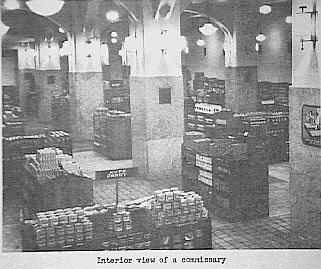
Assorted links:
My family lived in the area represented by the green circle next to the red arrow.
The red arrow points to the Grandstand and the blue arrows point to the race track.
The second photo titled "grandstands_1953" was also found on the web. What appears to be a wooden structure was not present back in the early '70s. The are where these people are standing had been overlaid with asphalt. To the left (and out of view of this picture) there was a "Motor Pool" where old vehicles and trailers were stored. During the five years we lived in Japan, there was a 40-foot trailer that had the "Bonanza" cast members painted on the side. I assume that it was used to haul gear to an from a filming location.
Map of POW camps; shows the name and location of the Negishi Race Course.
Map of Yokohama (1948) showing Negishi Racetrack.
Map of Yokohama dated August, 1949. In the lower left quarter of the map you will find the “Grand Stand.”
Another map of showing the location of the grandstand. The arrow with the Roman numeral IV is pointing to the location where General Douglas MacArthur lived while serving as SCAP. This was a widely held notion from the Japanese during our tour of duty (‘71 to ‘76). The arrow with the Roman numeral II is pointing to the location of our base quarters, 578-C. Directly behind our house is a Japanese cemetery (complete with a functioning crematorium). My Mom would have to take in the laundry whenever it was in operation. Otherwise you tend to get someone’s ashes on your clothes.
Photograph of the grandstand. It is thought to be from the Second World War, but I cannot verify that piece of information.
Photographs inside one of the three remaining towers of the grandstand. Photos taken by urban explorers within the past five years.
On top of the grandstand. Notice the round windows in the towers. The building to the immediate left of the tower (located in the lower left quadrant) is “Landmark Tower”. This is the tallest building in Japan. It was built long after we returned stateside.
Picture thought to be taken in the late 1800’s . The race track was created back in 1866. The blue arrow points to the location of where General Douglas MacArthur lived while serving in Japan. The place is now a car dealership. There was also a “switch back” that vehicles could use. A large round mirror positioned at this location so that drivers from opposite directions could see and be made aware of approaching traffic. The yellow line illustrates the location of a stairway that I used to take. I would carry my 10-speed Katakura-brand bicycle up these stairs. The red arrow points to the interior of the race track. This was converted to an 18-hole golf course. It was closed back the early ‘70’s. I will include a picture of the “19th Hole” in a future email.
The grandstand when it was operational.
Inside the grandstand at ground level. If my memory serves me correctly, the room thought to be the POW room is on the left beyond the opening marked “Administrative Officer.”
Thought to be one of the “sky boxes” of the grandstand.
I call this “new construction” because one can see the back of a stairway behind the wall. Obviously the US Army and Navy did a considerable amount of retrofitting to this structure after it was acquired. It is what is known as a “spoil of war.”
Another view inside the ground floor.
Looking down to the ground floor. It is thought that the POW room is located on the right.
I believe this is an access point to one of the three remaining towers.
Inside one of the towers. Note the boarded up circular window to the right. The term “HEAD” is Navy for “bathroom.”
View from the grandstand (believed to be taken from the roof). The four-unit house is where my family and three other families resided. That is in the middle of the picture. Our house is the one with the tree growing in front of the house. The red line points to my house. That tree was not present when we lived there.
Photo from 1930.
Street level view of my house.
View of the grandstand from my front porch. A friend photographed this back in 2014.
Remains of the towers taken between 2010 and 2014 (I believe).
Shows the grandstand in the background. The original grandstand was a wooded structure that was consumed by a fire. This is the same fire that resulted from the “Great Kanto Plains” earthquake that destroyed much of Tokyo and Yokohama on September 1, 1923. That earthquake was so strong that it moved the “Great Buddha of Kamakura” two feet. The statue weighs in excess of 90 tons. The present grandstand was designed by H.H. Morgan and was constructed AFTER 1923 and before 1936 (?). That would place this picture in the mid 1930’s (I believe).
Grandstand seats, (what I believe to be) within the remaining three towers.
Grandstand towers, the exterior of what is shown in the previous picture.
View that we would see as we drove to and from church. The three towers are visible in the center of the picture.
The three towers, appears to be in a state of deconstruction.
Negishi Heights neighborhood map. This and other maps were present during our tour.
Different view of the three towers.
Aerial view of the race track. The grandstand is visible in the top left corner. The green arrows show the race track and the red arrow points to the grandstand.
The grandstand. The yellow arrow points to the location of the Barber Shop. The red arrow points to the concrete stairway that led to the Navy Exchange “Stop-N-Shop.”
More interior pictures:
This commissary is said to have been inside the grandstand. During the war, the Japanese printed counterfeit currency inside this building. After the war, those printing presses were discovered somewhere in the basement (it has a four story basement which used to be visible from the outside) and were used to print the entire surrender documents in English, Japanese, Chinese and Korean for distribution throughout the vanquished Japanese Empire.

Assorted links:
http://www.totorotimes.com/negishi-grandstand-racecourse-yokohama/
http://www.totorotimes.com/negishi-racecourse-yokohama-story/
http://www.michaeljohngrist.com/2008/06/negishi-racecourse-ruins/#sthash.NwUD0ZZs.dpbs
http://injapan.gaijinpot.com/play/photography/2012/05/01/the-abandoned-negishi-grandstand/
http://www.drf.com/news/ruins-negishi-racetrack-tell-story-japan
http://www.haikyo.org/yokohama-negishi-racecourse/
https://en.wikipedia.org/wiki/Naval_Housing_Annex_Negishi
https://en.wikipedia.org/wiki/Negishi_Racecourse
https://punynari.wordpress.com/2010/04/03/negishi-horse-racetrack-in-sakura-season/
https://www.pinterest.com/pin/61080138666412280/
http://www.totorotimes.com/negishi-racecourse-yokohama-story/
http://www.michaeljohngrist.com/2008/06/negishi-racecourse-ruins/#sthash.NwUD0ZZs.dpbs
http://injapan.gaijinpot.com/play/photography/2012/05/01/the-abandoned-negishi-grandstand/
http://www.drf.com/news/ruins-negishi-racetrack-tell-story-japan
http://www.haikyo.org/yokohama-negishi-racecourse/
https://en.wikipedia.org/wiki/Naval_Housing_Annex_Negishi
https://en.wikipedia.org/wiki/Negishi_Racecourse
https://punynari.wordpress.com/2010/04/03/negishi-horse-racetrack-in-sakura-season/
https://www.pinterest.com/pin/61080138666412280/
